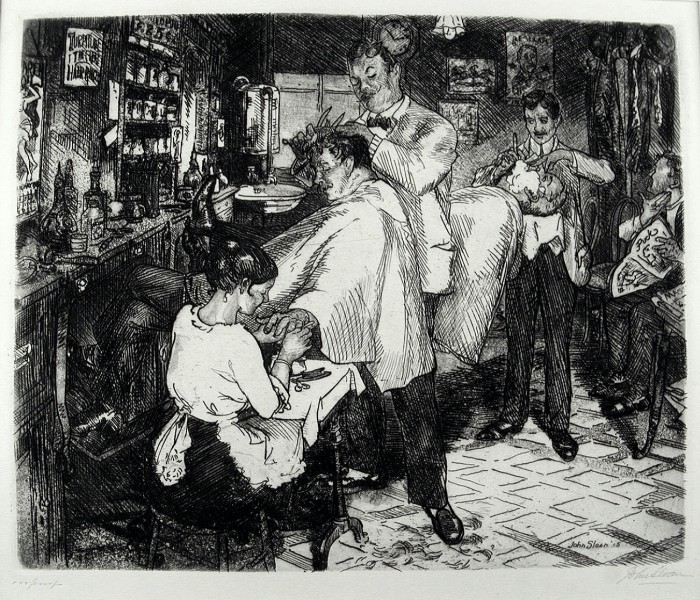Barbershop

John Sloan (1871-1954) Barbershop, 1915, etching and aquatint, signed, titled and inscribed “100 proofs” in pencil; also signed and inscribed “imp” by the printer Peter Platt [also signed and dated in the plate]. Reference: Morse 173, third state of three. On cream wove paper, in very good condition (with the drying holes in outer margins top and bottom that characterize the impressions printed by Platt), with wide margins, traces of pale time stain, 9 7/8 x 12, the sheet 12 3/4 x 17 3/4 inches, archival mounting. From the total printing of only 35.
A fine impression, in a dark brownish/black ink.
Although Sloan routinely wrote an edition size of 100 on his prints, many were printed in small numbers; the total printing of Barbershop was only 35.
Peter Platt was one of the most eminent of the printers who printed for Sloan, and one of Sloan’s favorite printers. After printing a proof he tacked it up to dry, and did not later trim the print so that the holes would not be evident; hence the tacking holes which characterize the Platt proofs. Cream wove paper was a favored Platt paper.
This is not only one of Sloan’s most successful compositions, it is also one of his most ambitious efforts in printmaking. In later years Sloan wrote these technical notes about this print: “Done on a zinc plate, which is not susceptible to delicate biting. The linework was etched first, then the plate coated with powdered resin and prepared for aquatint in the usual manner. The lightest areas were blocked out first with stopping-out varnish, then the medium darks while the darkest darks were exposed the longest to the acid bath. I don’t remember making any previous experiment with aquatint.”
Sloan’s success in capturing this scene – and an era as well – is obvious. Less obvious are little touches throughout the composition, e.g., the sign upper left (“Turpitude the Great Hair Raiser”), the typical barbershop calendar at the left, the issues of The Masses on the table at right (though the waiting customer is reading Puck).